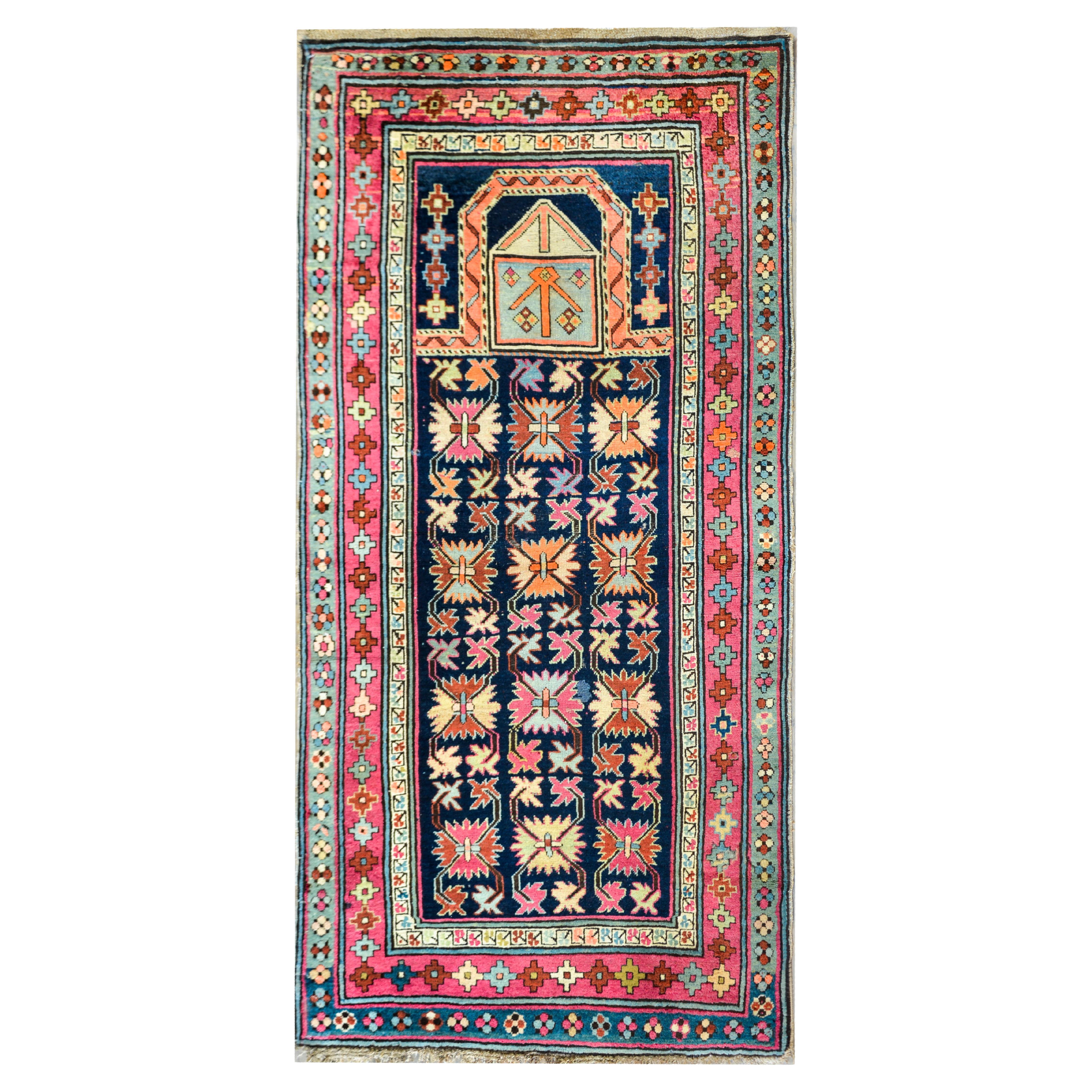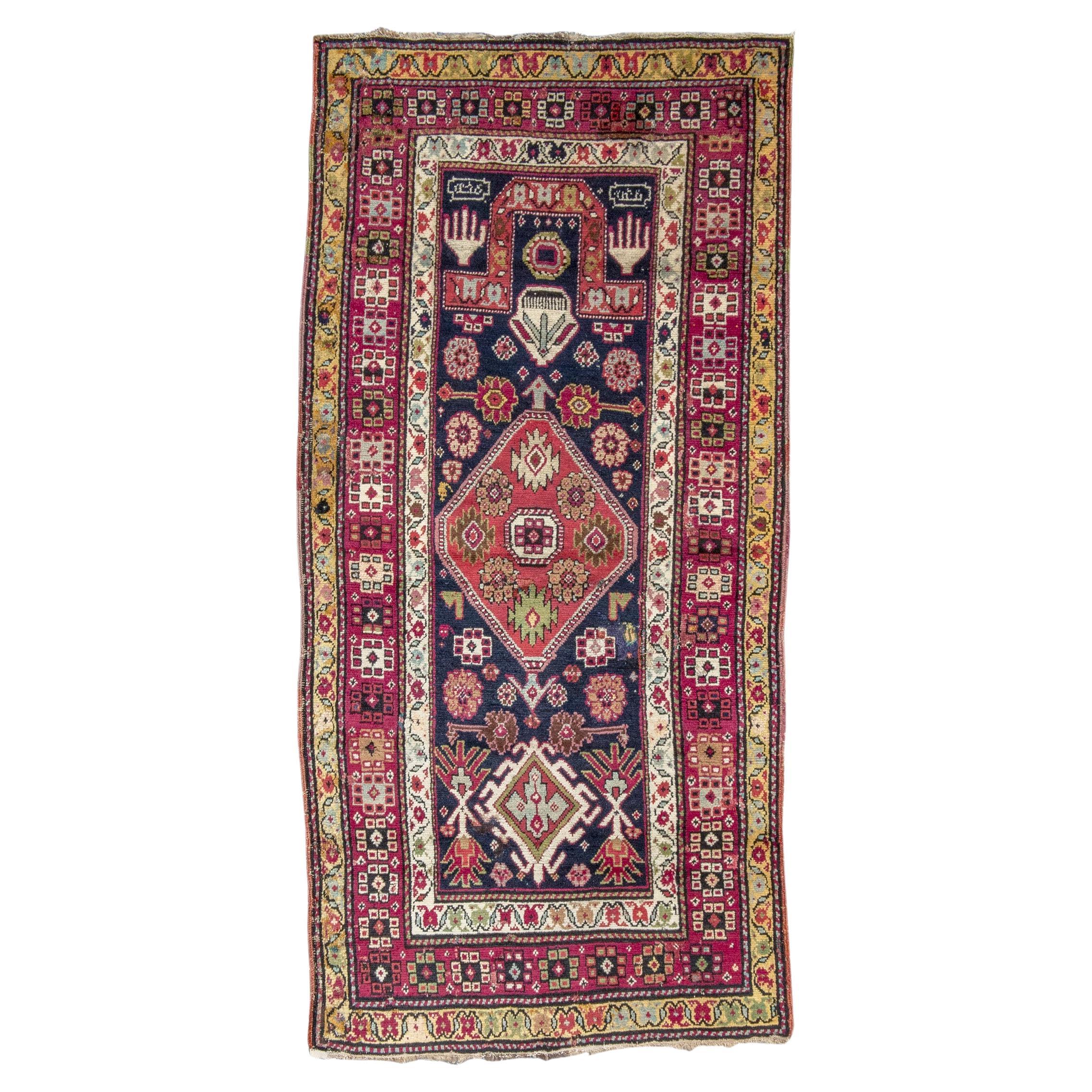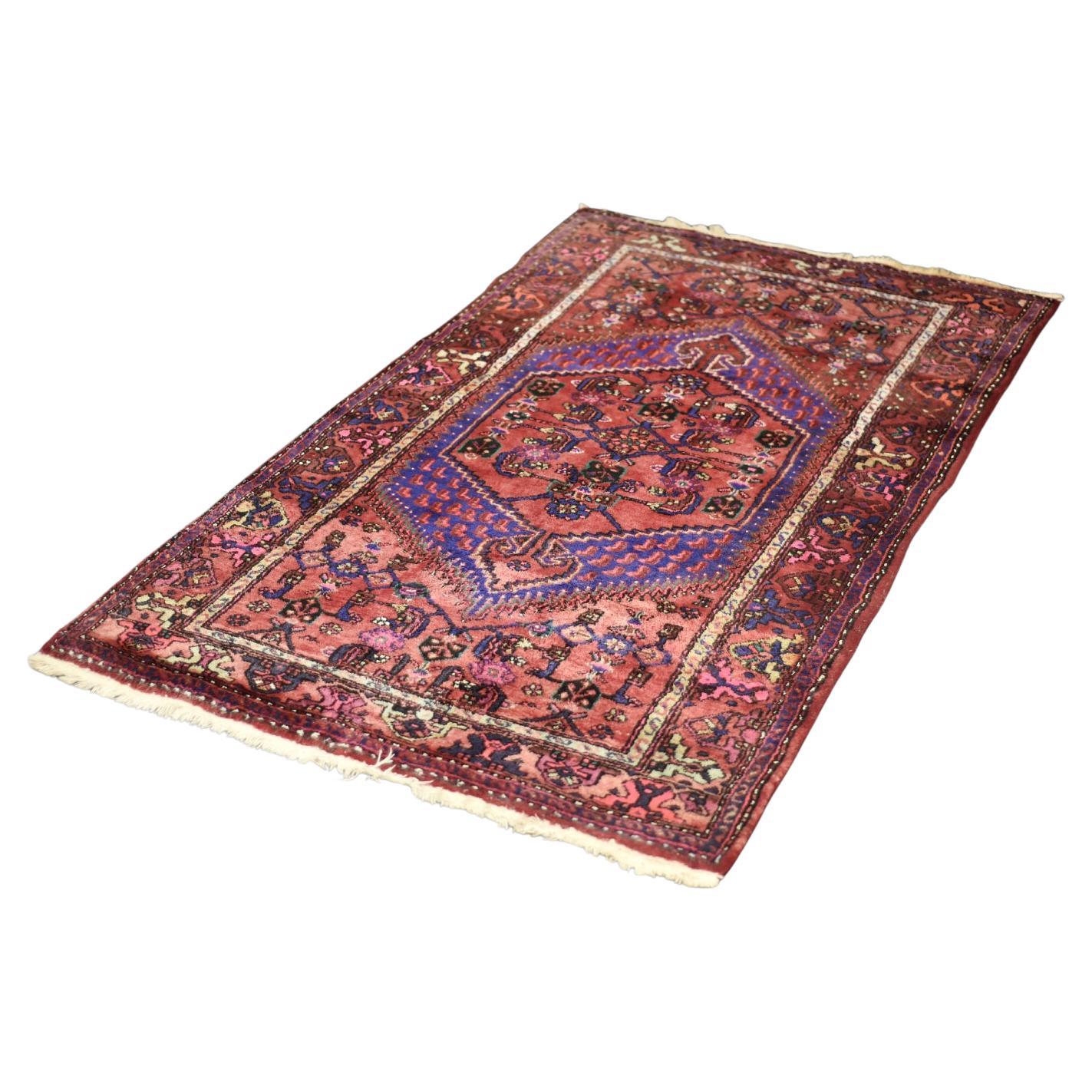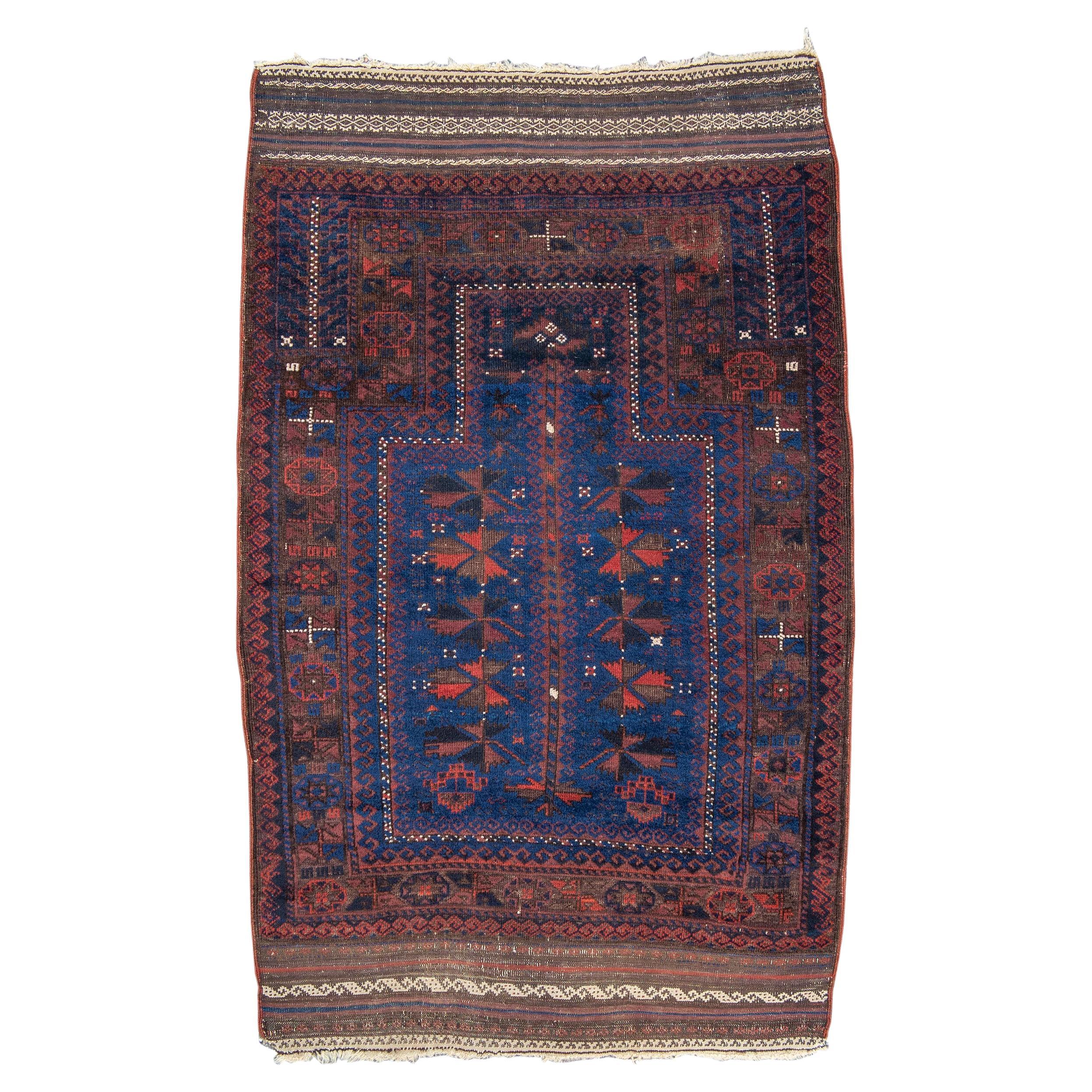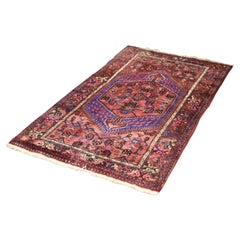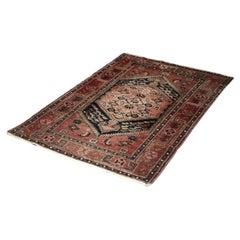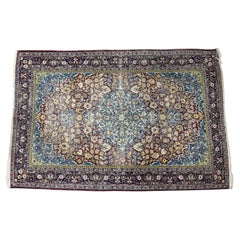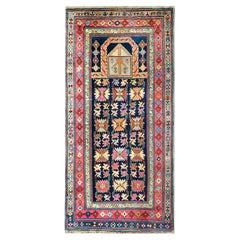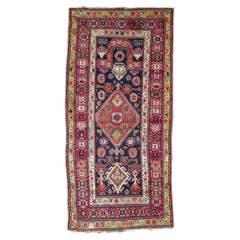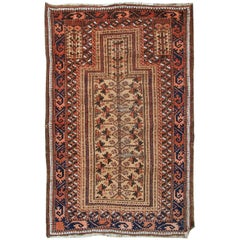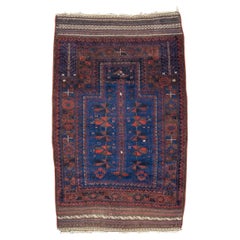Objekte ähnlich wie Vintage Hand-Woven Middle Eastern Oriental Baluch Prayer Rug, 1960s
Möchten Sie mehr Bilder oder Videos?
Zusätzliche Bilder oder Videos von dem*der Anbieter*in anfordern
1 von 19
Vintage Hand-Woven Middle Eastern Oriental Baluch Prayer Rug, 1960s
1.469,85 €Einschließlich MwSt.
Angaben zum Objekt
This hand-woven Baluch prayer rug was made in Iran during the 1960s. Woven using a traditional technique called flat weaving, and dyed in shades of red, beige, blue, green and turquoise. This rug has a richly decorated, distinct pattern with a strongly accentuated mihrab in the central part.
Baluch prayer rugs are a type of rug that is made by the Baluch tribe, who inhabit the areas of eastern Iran, Afghanistan and western Pakistan. These rugs have distinctive features that distinguish them from other types of Persian rugs, especially in the context of prayer rugs. A key feature of Baluch prayer rugs is the presence of a mihrab, an arched pattern symbolizing a prayer niche that indicates the direction of Mecca's qibla. These rugs are often decorated with geometric motifs such as rhombuses, triangles, and stripes. The mihrab is usually surrounded by these geometric patterns. In addition to the mihrab, you can also find images of trees of life, stylized flowers and motifs referring to elements of nature and tribal life. The dominant colors are dark shades of red, brown, navy blue and black. White or cream accents are also often used. As with other traditional rugs, the colors are obtained from natural dyes, which gives Baluch rugs a deep and rich color scheme. These rugs are most often woven from wool, which is hand-spun. In some cases, goat wool is also used. The warp can be made of wool or cotton, which ensures the durability of the rug. The knot used in Baluch rugs is usually a symmetrical knot, the so-called Turkish knot. It makes the rugs dense and durable. The knot density is usually medium, which allows for the creation of clear but relatively simple patterns. These rugs are an expression of the Baluch tribal culture, reflecting their nomadic lifestyle and strong ties to Islamic traditions. They are valued for their authenticity, handcraft, and distinct style that is both functional and aesthetic. Baluch prayer rugs are primarily used for religious purposes. They serve as prayer mats on which believers kneel during prayer. In addition, due to their unique design and colors, they are also valued as decorative interior elements, can be hung on walls or placed on the floor in places of prayer or meditation. They are an example of the combination of tribal art with spiritual needs, while maintaining practicality and durability.
The rug is in original vintage condition. It has signs of wear due to its age. Minor losses on the flecce. Before shipping, the rug will be professionally cleaned and will be ready for use.
- Maße:Breite: 91 cm (35,83 in)Länge: 162 cm (63,78 in)
- Stil:Sonstiges (Im Stil von)
- Materialien und Methoden:
- Herkunftsort:
- Zeitalter:
- Herstellungsjahr:circa 1960
- Zustand:Abnutzung dem Alter und der Nutzung entsprechend. The rug is in original vintage condition. It has signs of wear due to its age. Minor losses on the flecce.
- Anbieterstandort:Warszawa, PL
- Referenznummer:1stDibs: LU6129245384582
Anbieterinformationen
5,0
Gold-Anbieter*in
Premium-Anbieter*innen mit einer Bewertung über 4,3 und 24 Stunden Reaktionszeit
Gründungsjahr 2010
1stDibs-Anbieter*in seit 2021
51 Verkäufe auf 1stDibs
Typische Antwortzeit: <1 Stunde
- VersandAngebot wird abgerufen …Versand von: Warszawa, Polen
- Rückgabebedingungen
Einige Inhalte dieser Seite wurden automatisch übersetzt. Daher kann 1stDibs nicht die Richtigkeit der Übersetzungen garantieren. Englisch ist die Standardsprache dieser Website.
Authentizitätsgarantie
Im unwahrscheinlichen Fall eines Problems mit der Echtheit eines Objekts kontaktieren Sie uns bitte innerhalb von 1 Jahr für eine volle Rückerstattung. DetailsGeld-Zurück-Garantie
Wenn Ihr Objekt nicht der Beschreibung entspricht, beim Transport beschädigt wurde oder nicht ankommt, kontaktieren Sie uns bitte innerhalb von 7 Tagen für eine vollständige Rückerstattung. DetailsStornierung innerhalb von 24 Stunden
Sie können Ihren Kauf jederzeit innerhalb von 24 Stunden stornieren, ohne jegliche Gründe dafür angeben zu müssen.Geprüfte Anbieter*innen
Unsere Anbieter*innen unterliegen strengen Dienstleistungs- und Qualitätsstandards, wodurch wir die Seriosität unserer Angebote gewährleisten können.Preisgarantie
Wenn Sie feststellen, dass ein*e Anbieter*in dasselbe Objekt anderswo zu einem niedrigeren Preis anbietet, werden wir den Preis entsprechend anpassen.Zuverlässige weltweite Lieferung
Unsere erstklassigen Versandunternehmen bieten spezielle Versandoptionen weltweit, einschließlich individueller Lieferung.Mehr von diesem*dieser Anbieter*in
Alle anzeigenVintage Hand-Woven Middle Eastern Oriental Hamadan Rug, 1960s
This hand-woven oriental Hamadan rug was made in Iran during the 1960s. It is flat woven carpet - woven using traditional technique. This rug is dyed in shades of rustic red, pink an...
Kategorie
Vintage, 1960er, Persisch, Sonstiges, Perserteppiche
Materialien
Wolle
Handgewebter orientalischer Hamadan-Teppich aus dem Nahen Osten, 1960er Jahre, Vintage
Dieser handgeknüpfte Orientteppich aus Hamadan wurde in den 1960er Jahren im Iran hergestellt. Traditionell flach gewebt und in rustikalen Rot- und Indigoblau-Tönen gefärbt. Hamadan-...
Kategorie
Vintage, 1960er, Persisch, Moderne der Mitte des Jahrhunderts, Persertep...
Materialien
Wolle
Handgewebter orientalischer Hamadan Kamse-Teppich aus dem Nahen Osten, 1960er Jahre, Vintage
Dieser westpersische handgewebte Teppich stammt aus der Region Hamadan im Iran, am Rande der Kamse. Er stammt aus den 1960er Jahren und ist dicht gewebt aus reiner Wolle aus lokaler ...
Kategorie
Vintage, 1960er, Persisch, Moderne der Mitte des Jahrhunderts, Persertep...
Materialien
Wolle
Vintage Hand-Woven Middle Eastern Oriental Isfahan Rug, 1940s
This hand-woven oriental Isfahan carpet was made in the city of Isfahan in central Iran, during the 1940s. It is naturally dyed in shades of deep red, blue and yellow. The colours in...
Kategorie
Vintage, 1940er, Persisch, Sonstiges, Perserteppiche
Materialien
Wolle, Seide
Handgewebter orientalischer Hamadan-Teppich aus dem Nahen Osten, 1960er Jahre, Vintage
Dieser handgewebte orientalische Hamadan-Teppich wurde in den 1960er Jahren im Iran hergestellt. Traditionell flach gewebt und mit natürlich gewonnenen Farbstoffen gefärbt, weist der...
Kategorie
Vintage, 1960er, Persisch, Sonstiges, Perserteppiche
Materialien
Wolle
Antiker handgewebter Heriz-Teppich aus dem Nahen Osten, 1920er Jahre
Dieser handgewebte antike Teppich wurde in den 1920er Jahren in Persien (heute Iran) geknüpft. Die Stadt Heriz befindet sich im Nordwesten des Iran. In der Stadt und ihrer Umgebung w...
Kategorie
Vintage, 1920er, Persisch, Sonstiges, Perserteppiche
Materialien
Wolle, Baumwolle
Das könnte Ihnen auch gefallen
Seltener persischer Ganjeh-Gebetteppich aus dem frühen 20. Jahrhundert
Eine wunderschöne und seltene frühen 20. Jahrhundert persischen Ganjeh Gebetsteppich mit den schönsten stilisierten Blumen-und Blatt-Muster gewebt in wunderbaren hellen rosa, orange,...
Kategorie
Antik, Frühes 20. Jhdt., Persisch, Stammeskunst, Perserteppiche
Materialien
Wolle
Antiker persischer Karabagh-Gebetteppich, 19. Jahrhundert
Antiker Karabagh Gebetsteppich, 19. Jahrhundert
Zusätzliche Informationen:
Abmessungen: 5'9" L x 2'7" W
Herkunft: Kaukasus
Zeitraum: 19. Jahrhundert (4. Quartal)
Teppiche ID: 24098
Kategorie
Antik, 19. Jahrhundert, Kaukasisch, Kaukasische Teppiche
Materialien
Wolle
Handgefertigter antiker afghanischer Baluch-Gebetteppich, 1900er Jahre, 1C529
Dieser Gebetsteppich von Baluch ist im Originalzustand, er hat einige kleine Altersabnutzungen und alte Restaurierungen auf der Rückseite. Heller Braunton auf dem Feld und rote Verzi...
Kategorie
Frühes 20. Jahrhundert, Afghanisch, Zentralasiatische Teppiche
Materialien
Wolle
Antiker afghanischer Belutschen-Gebetsteppich, Ende 19. Jahrhundert
Antiker afghanischer Belutschen-Gebetsteppich, Ende 19. Jahrhundert
Ein großzügig gezeichneter Gebetsteppich mit blauem Grund, möglicherweise aus Nordostpersien. Die komplexe primär...
Kategorie
Antik, Spätes 19. Jahrhundert, Afghanisch, Zentralasiatische Teppiche
Materialien
Wolle
Antiker Marashali Gebetsteppich - Marasali-Teppich aus dem späten 19. Jahrhundert
Kaukasischer Gebetsteppich Marasali, Ende des 19. Jahrhunderts
Größe: 115 x 143 cm
Dieser beeindruckende kaukasische Maraschali-Teppich aus dem späten 19. Jahrhundert ist ein Meiste...
Kategorie
Antik, Spätes 19. Jahrhundert, Kaukasisch, Kaukasische Teppiche
Materialien
Wolle
Antiker Mucur (Mudjar / Mujur) Gebetsteppich - Türkischer Mittel Anatolischer Teppich
Dies ist ein antiker Mucur-Teppich aus Zentralanatolien, der Region Kırsehir, mit rotem Hintergrund, gutem Zustand und schöner Farbkomposition.
Die Stadt Mudjar (oder Mucur) liegt ...
Kategorie
Frühes 20. Jahrhundert, Türkisch, Oushak, Türkische Teppiche
Materialien
Wolle, Naturfaser, Organisches Material
10.592 €
Kostenloser Versand
